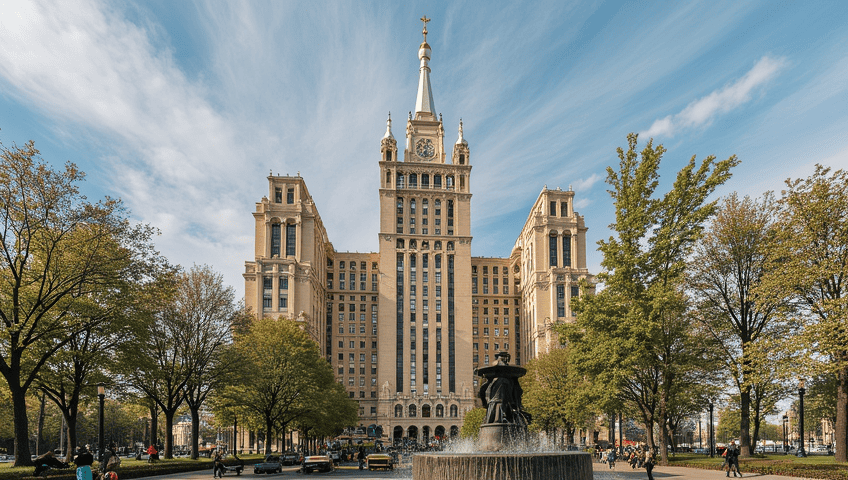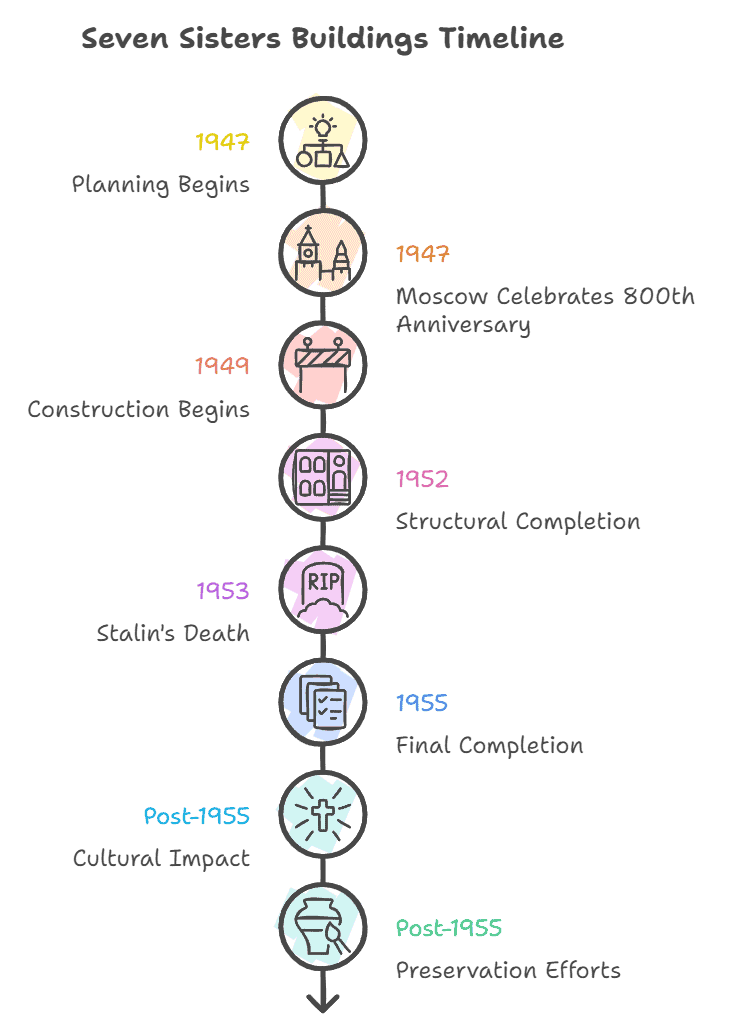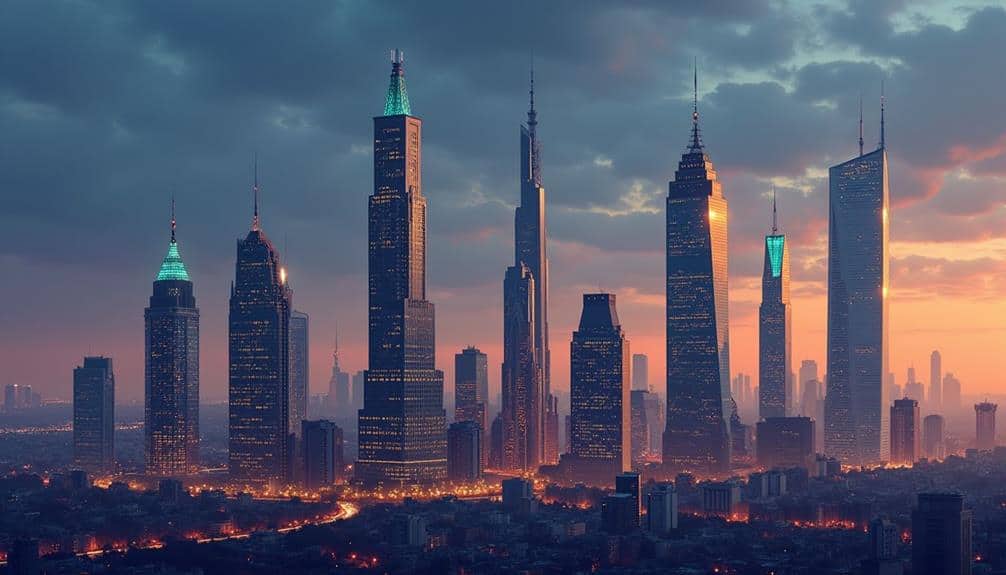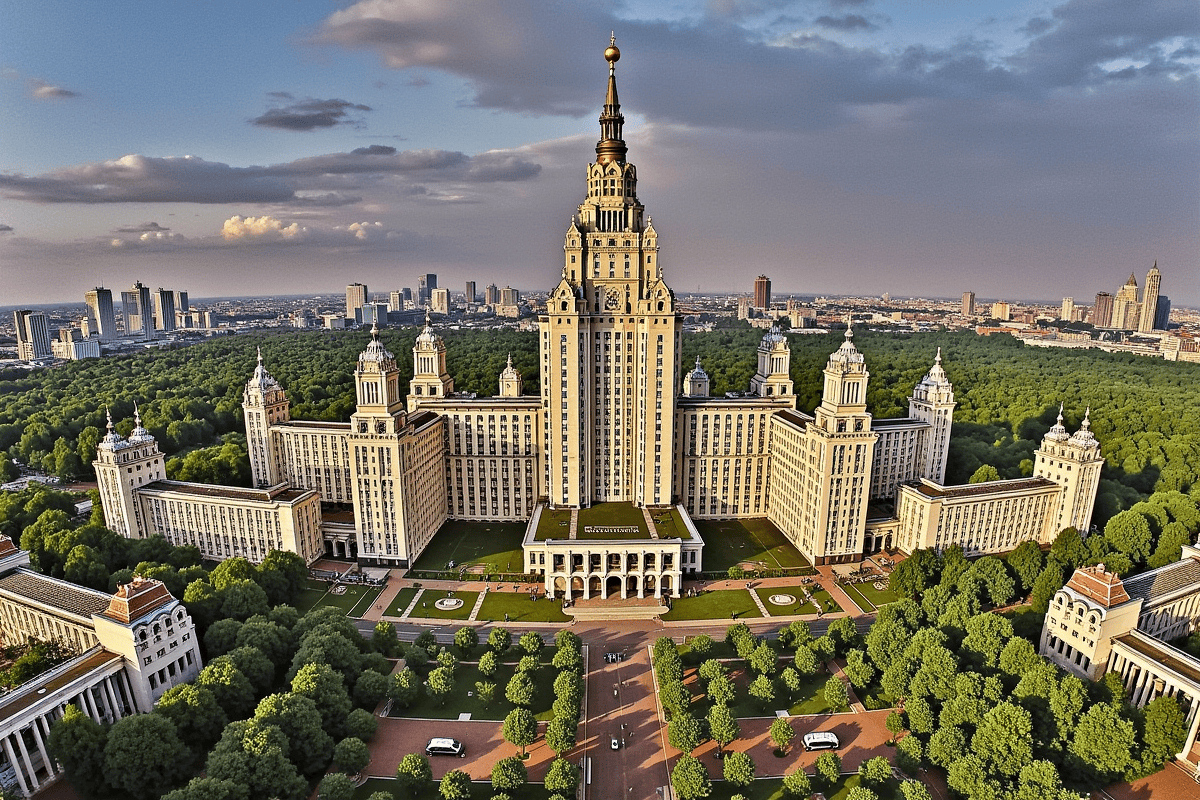Origins and Vision

Artist rendition of Kudrinskaya Square Building
The inception of the 7 Sisters Buildings, a group of iconic skyscrapers in Moscow, can be traced back to the post-World War II era when Soviet leader Joseph Stalin envisioned a grand architectural project that would symbolize the might and progress of the Soviet Union.
This vision was part of a broader strategy to demonstrate the USSR’s recovery and emergence as a superpower. The ambition was to create monumental structures that would stand as enduring symbols of Soviet strength and resilience.
Stalin’s vision for these buildings was also influenced by the desire to compete with Western skyscrapers, especially those in the United States. The aim was to blend Soviet architectural traditions with modern high-rise construction, creating a distinctive Soviet aesthetic that would convey both power and sophistication.
Watch our conversational video on Moscow’s 7 Sisters: The Skyscrapers That Shaped a Nation!
The project was intended to reflect the ideological and technological prowess of the Soviet state, projecting an image of a forward-thinking nation grounded in its socialist principles.
The construction of the 7 Sisters began in the late 1940s, driven by this grand vision. Each building was carefully planned to serve various purposes, including government offices, residential apartments, and educational institutions, further establishing their significance within the urban landscape of Moscow.

Design and Style
Design and style of the 7 Sisters Buildings are characterized by their imposing grandeur and unique blend of neoclassical and Gothic elements, which set them apart from other skyscrapers of their time.
These architectural marvels, constructed during the Stalinist era, embody a distinct fusion of styles that reflect both Soviet ideology and traditional Russian aesthetics. The neoclassical influence is evident in their symmetrical layouts, grandiose columns, and elaborate façade decorations, which evoke a sense of timeless elegance and power.
Gothic elements contribute to the buildings’ vertical emphasis, with soaring spires and intricate detailing that enhance their majestic presence in the skyline. The use of pointed arches and ribbed vaults adds to the complexity and beauty of the structures, creating a visual dialogue between historical reverence and modern ambition.
Each of the seven buildings is crowned with a distinctive spire, a hallmark of their design, symbolizing aspirations towards progress and enlightenment.
Incorporating advanced engineering techniques of the period, the 7 Sisters Buildings also feature robust frameworks and durable materials that guarantee their longevity.
This combination of stylistic grandeur and structural integrity has made them enduring icons of architectural excellence.
Architectural Challenges

Constructing the 7 Sisters Buildings posed significant architectural challenges that tested the limits of mid-20th-century engineering and design capabilities. These skyscrapers were ambitious endeavors, requiring innovative solutions to address the structural and aesthetic demands of the Stalinist architectural vision.
The primary challenge was to create buildings that were not only monumental in scale but also structurally sound in an era before advanced computer modeling. Engineers had to devise methods to guarantee stability, particularly given Moscow’s variable soil conditions. Deep and robust foundations were essential to support the immense weight of these towering structures.
Additionally, the integration of complex internal frameworks to distribute loads effectively was critical to their lasting durability. Another significant challenge was the incorporation of intricate decorative elements without compromising structural integrity. The ornate facades, spires, and grandiose elements demanded precision craftsmanship and the use of innovative materials.
Balancing aesthetic grandeur with practical engineering constraints required a collaborative effort between architects and engineers. Moreover, the logistics of sourcing and transporting vast quantities of construction materials during the post-war era posed additional hurdles.
The need for high-quality materials, coupled with the scale of the projects, necessitated meticulous planning and coordination. These multifaceted challenges underscored the remarkable achievements in bringing the 7 Sisters Buildings to fruition.
Construction Timeline
Initiating the construction timeline of the 7 Sisters Buildings reveals a meticulously planned and executed series of phases that spanned from the late 1940s into the mid-1950s. This ambitious project was emblematic of Stalinist architecture, designed to symbolize Soviet power and modernity.
The planning phase commenced in 1947, coinciding with the 800th anniversary of Moscow. A decree was issued by the Council of Ministers, marking the official start.
Construction officially began in 1949, with initial groundwork and foundation laying. The use of advanced engineering techniques and the mobilization of a vast workforce, including prisoners, underscored the Soviet regime’s commitment to this monumental task. Each building had its own timeline, but all adhered to a centralized schedule that allowed for parallel progress.
Despite numerous challenges, including material shortages and harsh weather conditions, the construction proceeded steadfastly. By 1952, the structural framework of most buildings was nearing completion.
The final stages involved intricate detailing and interior works, culminating in the completion of the last of the seven in 1955. This period of intense construction activity not only transformed Moscow’s skyline but also demonstrated the Soviet Union’s architectural and engineering prowess.
Individual Buildings

Among the seven iconic edifices collectively known as the 7 Sisters Buildings, each structure stands as a hallmark to the unique architectural and cultural ambitions of the Soviet era.
These skyscrapers, built between 1947 and 1953 under the directive of Joseph Stalin, embody the Soviet Union’s desire to showcase its prowess in engineering and its distinctive Socialist-Realist aesthetic.

Artist rendition of Moscow State University
The Moscow State University (MSU) building, the tallest of the group, soars to a height of 240 meters and epitomizes academic grandeur. Its imposing spire and extensive use of ornamentation highlight the regime’s emphasis on education and intellectual supremacy.
The Ministry of Foreign Affairs building, another prominent structure, serves as a demonstration of the Soviet Union’s international aspirations. Its austere façade and robust design underscore the importance of diplomacy and statecraft during the Cold War.
The Hotel Ukraina, now the Radisson Royal Hotel, was designed to symbolize Soviet hospitality. It remains one of the largest hotels in Europe, with its neoclassical elements blending seamlessly with modern luxury.
Other notable buildings include the Leningradskaya Hotel, the Kudrinskaya Square Building, the Kotelnicheskaya Embankment Building, and the Red Gate Building, each contributing uniquely to Moscow’s skyline and the Soviet architectural narrative.
Cultural Impact
The cultural impact of the 7 Sisters Buildings extends far beyond their architectural significance, embodying the Soviet Union’s ideological narrative and serving as enduring symbols of its historical legacy. Erected during Stalin’s post-war era, these skyscrapers epitomize Soviet aspirations to rival Western architectural prowess, blending Russian Baroque and Gothic influences with American skyscraper forms. They were intended to project power, modernity, and the technological capabilities of the USSR, all while reinforcing the state’s dominance over the built environment.
Each building, meticulously designed and strategically placed, became a focal point in Moscow’s skyline, instilling a sense of awe and national pride. Their grandeur and scale were not just architectural feats but also tools of propaganda, illustrating the Soviet Union’s commitment to progress and superiority.
Additionally, these buildings played critical roles in housing government officials, cultural institutions, and elite residential apartments, thereby intertwining with the daily lives of influential Soviet citizens.
In popular culture, the 7 Sisters have inspired numerous artistic works, from literature and films to paintings, reflecting their stature as icons of Soviet ambition. Their imposing silhouettes continue to evoke reflections on the era’s socio-political milieu, symbolizing both the grandeur and the complexities of Soviet history.
Legacy and Preservation

Preserving the legacy of the 7 Sisters Buildings has become a focal point for both historians and conservationists, reflecting their enduring significance within Russia’s architectural and cultural heritage. Constructed under Stalin’s regime, these towering edifices symbolize the Soviet Union’s ambition and technological prowess during the post-World War II era. Each building, with its unique blend of Russian Baroque and Gothic styles, stands as a representation of the era’s architectural innovation and the political narrative of Soviet power.
Efforts to maintain and restore the 7 Sisters are multifaceted, involving both governmental and private entities. Preservation initiatives emphasize not only the structural integrity of these monumental buildings but also their historical and cultural contexts. Detailed restoration projects are undertaken to guarantee that original design elements and materials are meticulously conserved, while modern upgrades are seamlessly integrated to meet contemporary standards.
Public engagement plays a vital role in the preservation process. Educational programs, guided tours, and exhibitions are organized to foster appreciation and awareness among locals and tourists alike.




